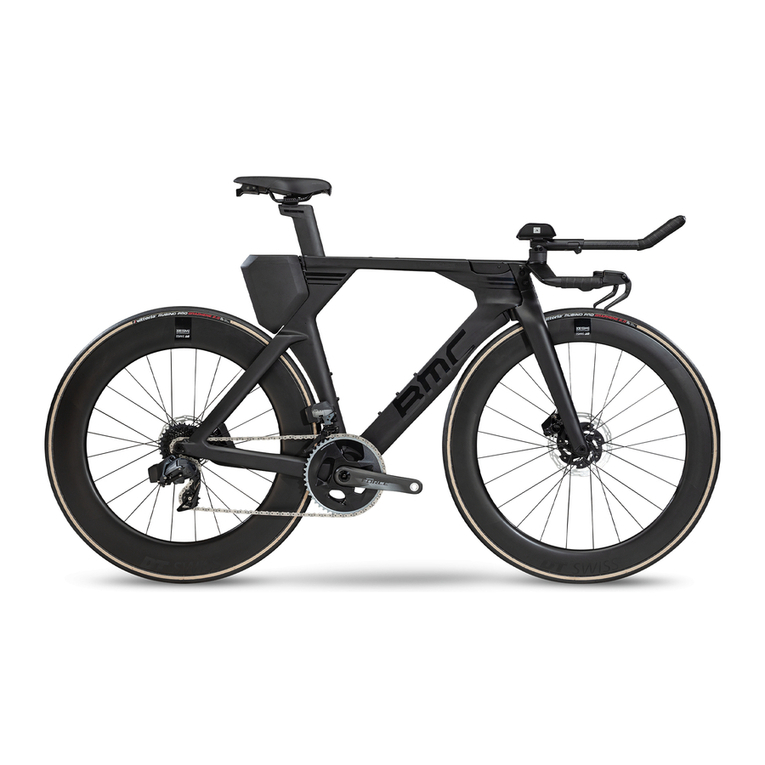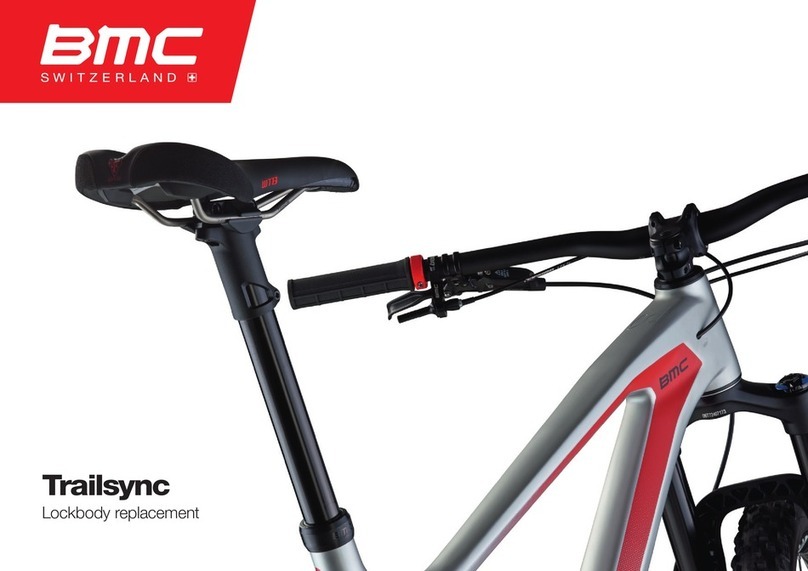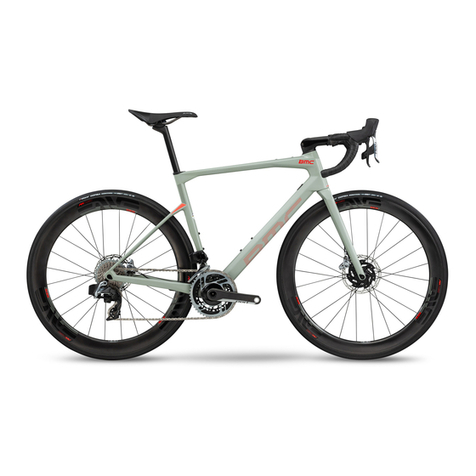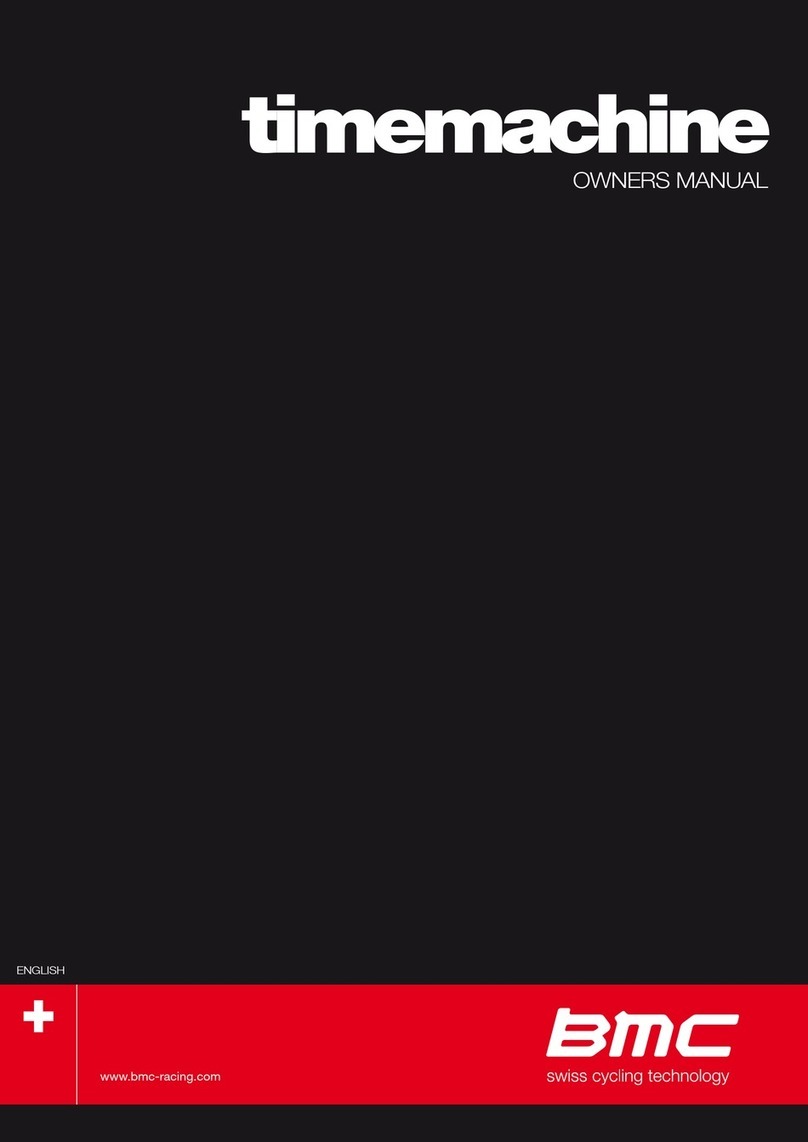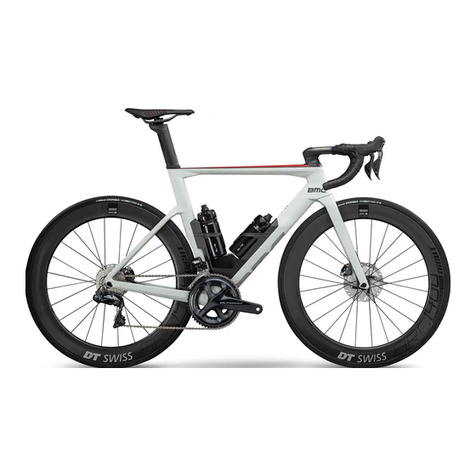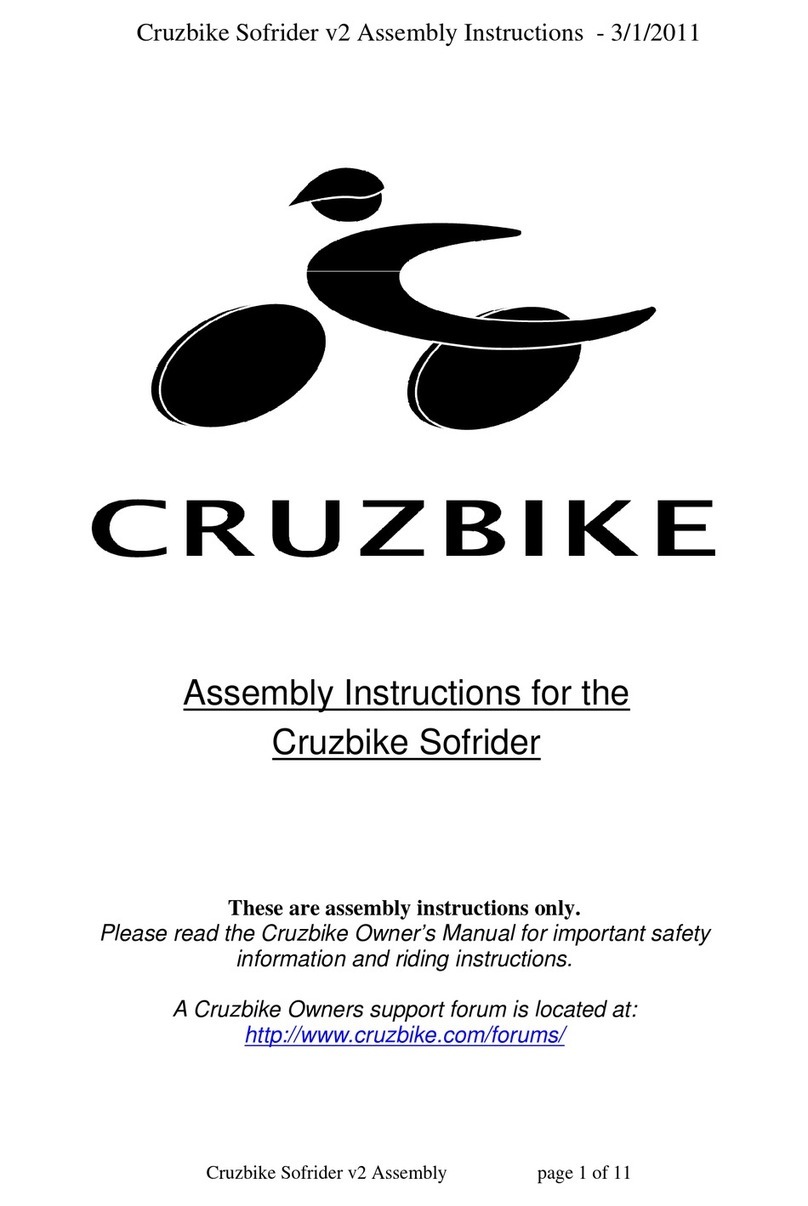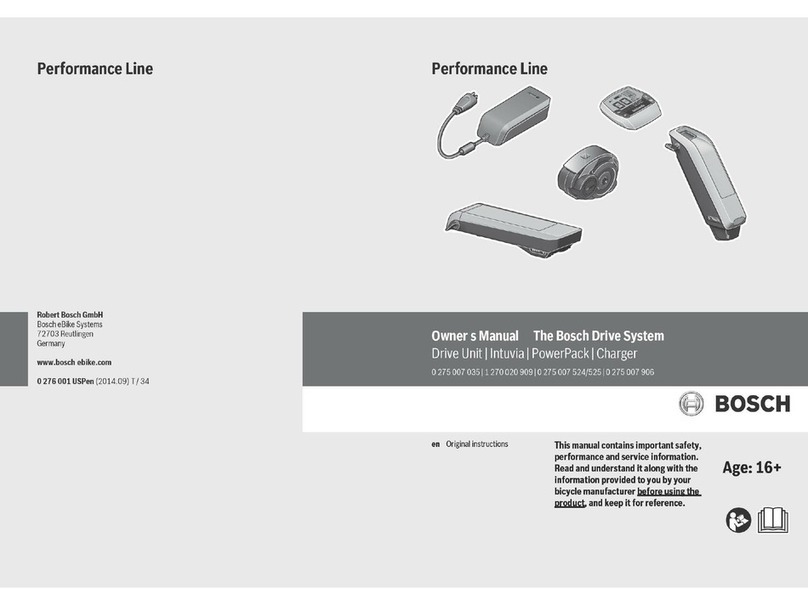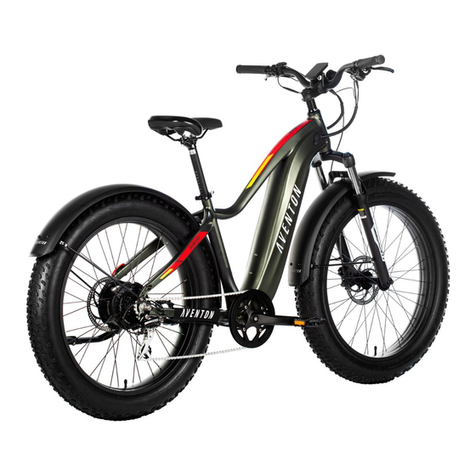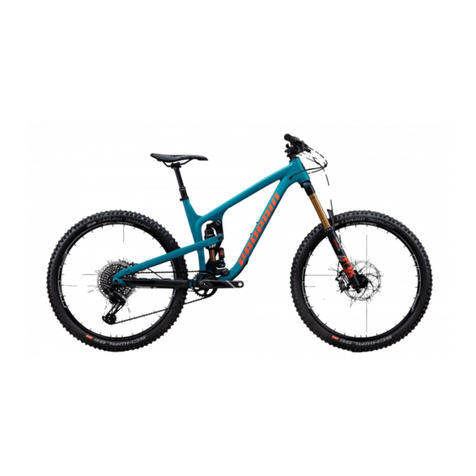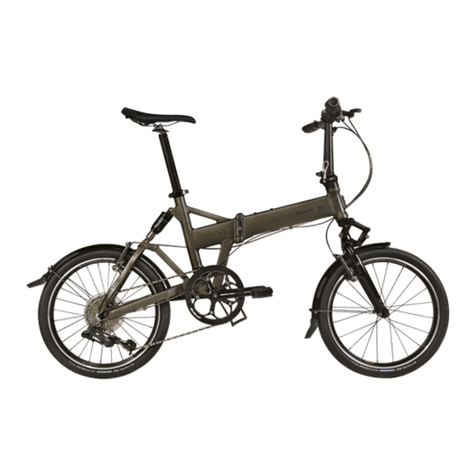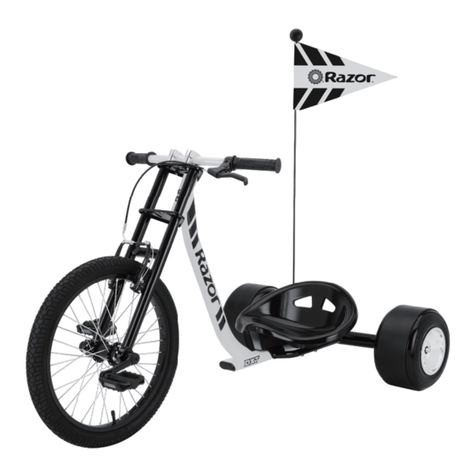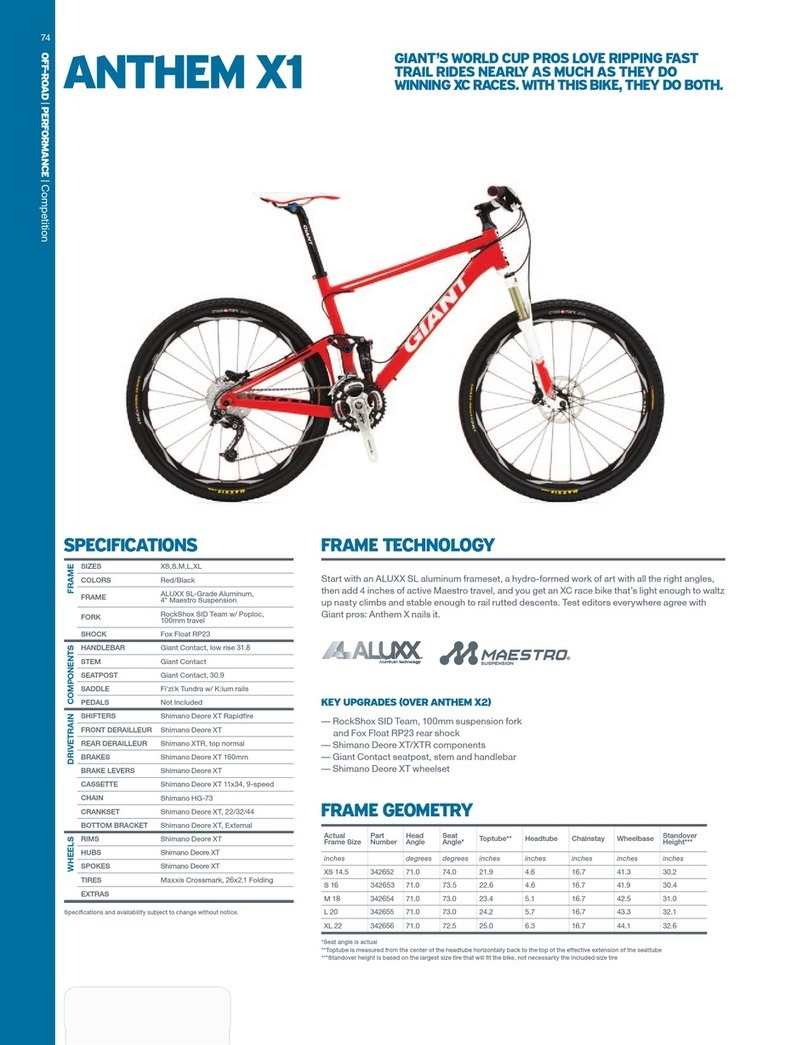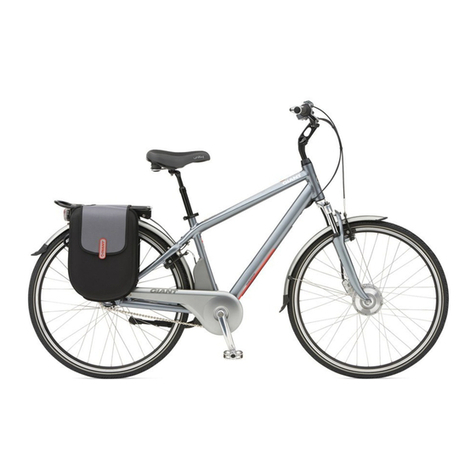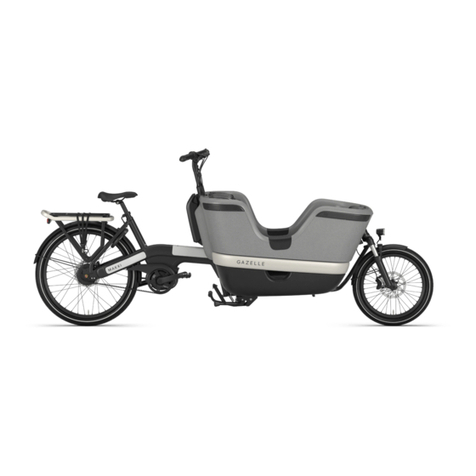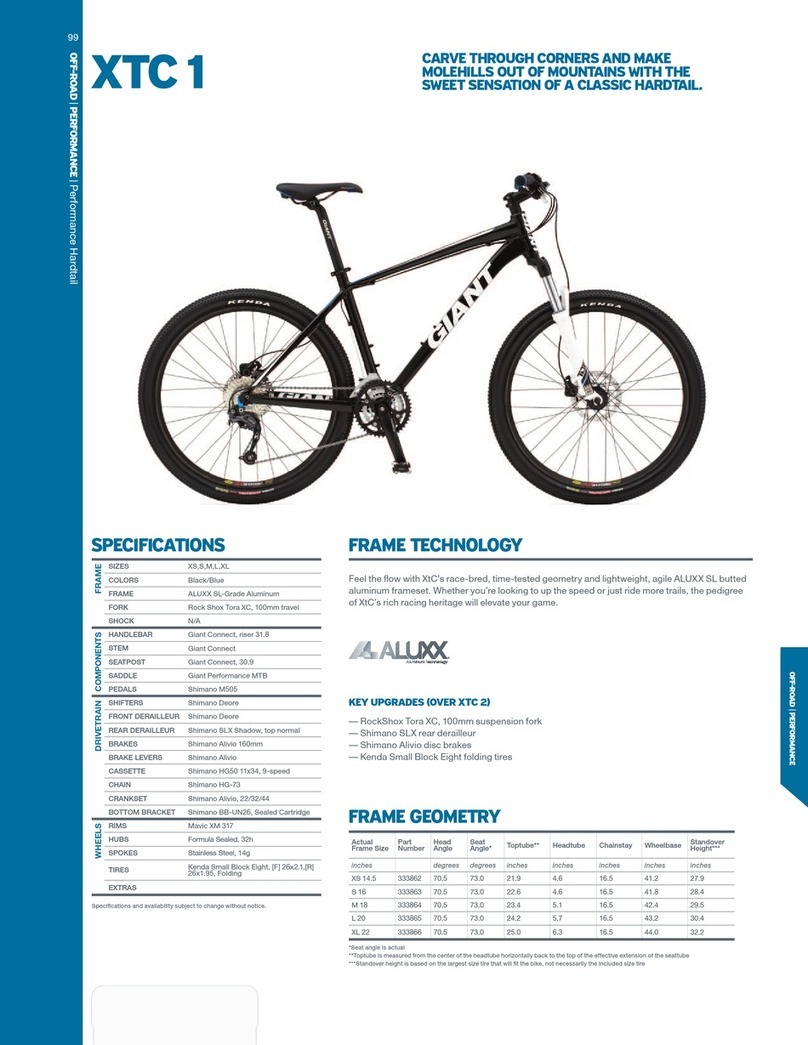BMC Team Machine SLR01 User manual

www.bmc-switzerland.com
teammachine SLR01
ASSEMBLY INSTRUCTIONS
MONTAGEANLEITUNG
INSTRUCTIONS DE MONTAGE

Content
ASSEMBLY INSTRUCTIONS
Introduction
Gear cable routing for mechanical shifting
Di2 gear cable routing
Rear brake cable
Headset and Fork Installation
Seat clamp & seat post Installation
Notes

Introduction
The new BMC teammachine SLR01 frameset and components are designed as a system to provide a very high level of riding
performance.
Integration being a key part of the system’s performance, it is necessary to understand that most components of the frameset
have been designed specifically for the new teammachine SLR01 and their function may slightly differ from your traditional road
bike “off the shelf” components.
The new BMC teammachine SLR01 uses all the latest and most high-end technologies that can be found in bicycle manufacturing,
including sharp edged and thin-walled carbon fibre composite construction, which should be treated with delicacy from the end
user to prevent permanent and sometimes invisible damage.
For the reasons mentioned above, we ask you to carefully follow the instructions provided in this manual.
Incorrect mechanical operation on your bicycle could lead to serious damage, which could cause you to fall and lead to
injury or death.
If you do not have the appropriate tools or experience to execute the following instructions, or if you need further
information, please contact your official BMC dealer for service of your bicycle.

Gear cable routing for mechanical shifting
1. Prepare the frame for mechanical gear routing with the DT stopper (1) and the cable guide below the right chain stays (2).
2. Insert the rear derailleur cable (later RD cable) through the DT (3) stopper and exit it through the long hole near the bottom
bracket (4). Repeat the operation for the front derailleur cable (later FD cable).
Note: For non-crossed shifting housings at cockpit (REAR cable entering right and FRONT cable entering left, as shown
on the pictures above), the two cables need to run parallel through the DT.
For crossed shifting housings at the cockpit (REAR cable entering left and FRONT cable entering right), the shifting
cables need to be crossed again through the DT.
Important: please note that twisted cables are prohibited for both configurations (crossed, non-crossed). This would lead
to inaccurate and bad shifting when changing gears.
1 2
3 4
NO

3. Run the cables through the BB cable guide and take care on the respective grooves for RD cable and FD cable.
4. Insert the FD cable through the hole running behind the bottom bracket.
5. Place the cable guide inside the specific recess below the bottom bracket by clipping it front side first 1 , then by pushing
straight on the FD cable 2 (5).
Complete by pushing in the middle of the cable guide straight on the clip 3 until you hear the “click” sound (6).
6. Run the RD cable through the cable guide below the chain stays, enter it at the bottom side of the chain stay and exit it through
the hole above the drop out.
Then, put on the DO stopper and push it inside the hole.
5 6

Note: the DO stopper is cylindrical. There is no flat surface on it, and in opposition with the rear brake cable stopper
(described in point 5. of section “Rear brake cable”)
Di2 gear cable routing
1. Prepare the frame for Di2 gear cable routing by installing the DT cover (1) and the BB cover as shown on the picture (2) below.
Please make sure that the BB cover is well clipped inside the frame (3).
When needed, please look at the instructions described in point 5. of section “Gear cable routing for mechanical
shifting”.
YES NO
1 2
3

2. Use a mechanical wire gear shifting cable to guide the Di2 rear derailleur wire through the chain stay.
Enter the frame at the drop out and exit at the bottom bracket.
3. Use a mechanical wire gear shifting cable to guide the Di2 main wire through the down tube. Enter at the hole on the head
tube and exit at the bottom bracket.
4. Insert the Di2 front derailleur wire from the hole located near the front derailleur and exit at the bottom bracket.
2. Use a mechanical wire gear shifting cable to guide the Di2 rear derailleur wire through the chain stay.
Enter the frame at the drop out and exit at the bottom bracket.
3. Use a mechanical wire gear shifting cable to guide the Di2 main wire through the down tube. Enter at the hole on the head
tube and exit at the bottom bracket.
4. Insert the Di2 front derailleur wire from the hole located near the front derailleur and exit at the bottom bracket.

5. Guide the wire from the top of the seat tube towards the bottom bracket and exit there.
6. Mount the battery inside the seat post:
- snap the threaded Battery adapter over the battery,
- screw in the adapter until the Hex touches the foam,
- connect the battery to the Di2 cable.
Note: Cutting the seatpost to maximum length of 80mm (measured from BOTTOM of seatpost) can be done without
affecting the structure of the seatpost.
WARNING: If the seatpost is cut, this is at the owner’s risk and BMC are not liable for any possible related issues. Once a
seatpost is cut, it also voids the warranty of that post.
7. Connect all Di2 wires coming out of the bottom bracket to the junction, please refer to Shimano installation instructions.
8. Push the wires and the junction back into the bottom bracket and the seat tube.

9. Install the Di2 plug at the drop out.
10. Install the Di2 grommets. Please refer to Shimano instructions.
Rear brake cable
1. Make sure that the frame is ready for the rear brake cable routing by checking the liner’s presence through the top tube.
2. Please refer to the following chart in order to pre-define the length of the rear brake cable housing.
This length (in mm) is measured from a point on the handlebar 60mm away from the center of the stem to the cable entrance
at the head tube:
* the spacers height includes the conical top cap below the spacers (low=8mm or high=15mm)
** the reference stem has an angle of -6°
Note: this table should be used as a guide only.
Spacers Stem length** (mm)
height* 80 90 100 110 120 130 140
<30mm 180 190 195 200 210 215 220
>30mm 185 195 200 205 215 220 225

3. Insert the cable through the liner.
4. Remove the liner by pulling backwards.
Note: the liner makes your life easier in case of cable replacement.
We suggest you to keep it in a nice storage place for the time you will need it again.
5. Insert the rear brake stopper out of the cable. Please make sure that the flat surface is directed downward when installing the
stopper inside the frame.

Note: the rear brake stopper has a flat surface on the retaining wall, differentiating it with the DO stopper (described in
point 6. of section “Cable routing for mechanical gear shifting”).
Headset and Fork Installation
1. Apply grease on the bearings (N°3 and 4) and on the bearing seats of the frame. Place the bearings in the frame.
2. Apply grease on the shaft and on the crown of the fork (N°5), and then slide it through the bearings and the head tube.
3. Slide the compression ring (N°2) over the fork shaft.
4. Slide the top cap (N°1) over the compression ring and then setup your stem.
Note: 2 different heights of top caps are delivered with the frame (low=8mm, high=15mm).
Feel free to use the one which matches your position the best.
Note: the fork crown is designed so that the lower bearing can seat directly on it. There is no need to add a metal ring.
YES NO

Seat clamp & seat post Installation
1. Install the saddle clamping hardware, by applying carbon friction paste at the lower clamp interface (between 2 and 5).
Bolts (3) are then assembled with upper seat clamp (1) through the seat post (5).
Take care that the spherical washers (4) are together with the bolts when assembling, and don’t exceed the maximum
torque of 7Nm when tightening.
2. Apply carbon friction paste on the lower part of the seat post (5) as well as on the inside of the seat tube.
3. Ensure that the seat clamp (6) is mounted on the frame.
4. Insert the seat post into the seat tube.
5. Tighten the seat post clamp bolt to 3Nm max.


Inhalt
MONTAGEANLEITUNG
Kabelführung für mechanische Schaltung
Di2 Schaltleitungsführung
Bremskabel fürHinterradbremse
Steuersatz- und Gabelmontage
Sattelklemmen- und Sattelstützenmontage
Notizen

Kabelführung für mechanische Schaltung
1. Bereiten Sie den Rahmen für die mechanische Schaltung vor, indem Sie den DT stopper (1) und die Kabelführung an der
Kettenstrebe (2) montieren.
2. Führen Sie das Schaltkabel für das hintere Schaltwerk durch den DT stopper in den Rahmen ein (3) und lassen sie es durch die
Öffnung vor dem Tretlager wieder austreten (4). Wiederholen Sie den Vorgang für das Schaltkabel des Umwerfers.
Hinweis: Wenn Sie die Schaltkabel vor dem Steuerrohr nicht kreuzen (das Kabel vom rechten Schalthebel [REAR] tritt
rechts ein, das vom linken Schalthebel [FRONT] links, wie oben abgebildet), verlaufen sie im Unterrohr parallel.
Bei gekreuzter Kabelführung (Rechtes Kabel [REAR] tritt links ein und linkes Kabel FRONT] tritt recht ein), müssen sich
die Kabel im Unterrohr kreuzen, um an der richtigen Seite auszutreten.
Wichtig: Vermeiden Sie, dass sich die Kabel im Unterrohr verwickeln (2x und mehr überkreuzen), ansonsten wird die
Schaltung nicht korrekt funktionieren.
1 2
3 4
Falsch

3. Führen Sie die Kabel durch die Kabelführung (BB Cable guide) und achten Sie darauf, für die Kabel von Umwerfer [FRONT] und
Schaltwerk [REAR] die dafür vorgesehenen Nuten zu nutzen.
4. Führen Sie das Umwerferkabel durch die dafür vorgesehene Bohrung an der Kabelführung und durch die Bohrung hinter dem
Tretlager am Rahmen.
5. Installieren Sie die Kabelführung in der dafür vorgesehenen Vertiefung unter dem Tretlager indem Sie sie vorne zuerst
einhängen 1 , um dann hinten den Zapfen in die Bohrung für das Schaltkabel zu drücken 2 (5).
Zuletzt drücken Sie den Zapfen in der Mitte der Kabelführung in die Bohrung in der Mitte des Tretlagers 3 .
Ein Klickgeräusch bestätigt das Einrasten der Kabelführung (6).
6. Führen Sie das hintere Schaltkabel durch die Kabelführung unter der Kettenstrebe. Schieben Sie es durch das Loch in die Strebe
und lassen es oberhalb des Ausfallendes wieder austreten.
Lassen Sie den Kabelstopper (DO stopper) über das Schaltkabel gleiten und drücken Sie ihn in die Öffnung wo das Kabel austritt.
5 6

Hinweis: Der “DO stopper” ist rund und besitzt keine flache Stelle oder Kerbe am Flansch, im Gegensatz zum
Bremskabelstopper (Beschrieben in Punkt 5 des Abschnitts „Hinteres Bremskabel“)
Di2 Schaltleitungsführung
1. Bereiten Sie den Rahmen für die elektronische Schaltung vor, indem Sie die Abdeckung am Unterrohr (DT cover Di2) (1) und unter
dem Tretlager montieren(2).
Stellen Sie sicher, dass die Abdeckung am Tretlager sauber eingeklickt ist (3).
Beachten Sie auch Punkt 5 des Abschnitts “Kabelführung für mechanische Schaltung“.
Richtig Falsch
1 2
3

2. Benutzen Sie ein mechanisches Schaltkabel als Hilfe, um die elektrischen Leitungen durch den Rahmen zu ziehen.
3. Ziehen Sie das Schaltwerkkabel vom Ausfallende her durch die Kettenstrebe und lassen sie es am Tretlager austreten.
4. Führen Sie das Hauptkabel durch die Bohrung links am Steuerrohr in den Rahmen ein und ziehen Sie es durch das Unterrohr,
bis es am Tretlager austritt.
5. Führen Sie das Umwerferkabel durch die Bohrung am Sitzrohr ein und lassen Sie es am Tretlager austreten.

6. Führen Sie das Batteriekabel durch das Sitzrohr, bis es am Tretlager austritt.
7. Installieren sie die Batterie in der Sattelstütze:
- Schieben Sie den Adapter mit Gewinde auf die Batterie bis er einschnappt.
- Schrauben Sie den Adapter in die Sattelstütze bis der Sechskant den Schaumstoff berührt.
- Verbinden sie die Batterie mit dem Di2 Kabel.
Hinweis: Die Sattelstütze kann um 80mm gekürzt werden, ohne die Struktur der Stütze zu schwächen.
WARNUNG: Das Kürzen der Sattelstütze geschieht auf eigene Gefahr. BMC lehnt jede Haftung ab für Schäden, die im
Zusammenhang mit dem Kürzen der Stütze entstehen.
8. Verbinden sie alle Kabel am Tretlager mit der Junction Box. Bitte hierzu die Shimano Installationsanleitung beachten.
9. Schieben Sie die Kabel und Junction Box zurück ins Tretlager und das Sitzrohr.

10. Montieren Sie die Di2 Dichtung (Di2 Plug DO) am Ausfallende.
11. Montieren Sie die Di2 Grommets entsprechend der Shimano Installationsanleitung.
Bremskabel für Hinterradbremse
1. Stellen Sie sicher, dass die rote Kunsttoffleitung im Oberrohr installiert ist und an beiden Enden aus dem Rahmen austritt.
2. Bitte beachten Sie folgende Tabelle, um die Länge der Bremshülle zwischen Lenker und Rahmen zu bestimmen.
Diese Länge (in mm) ist gemessen von einem Punkt 60mm von der Mitte des Lenkers, bis zum Kabelstopper am Steurrohr.
Um die komplette Länge der Hülle zu bestimmen, addieren sie dazu die Distanz von dem Punkt am Lenker bis zum
Bremshebel.
* Die Spacerhöhe wurde gemessen inklusive der konischen Abdeckkappe des Steuersatzes (8mm
oder 15mm).
** Der Referenzvorbau hat einen Winkel von -6°
Hinweis: Diese Tabelle ist nur eine Richtlinie, alle Angaben ohne Gewähr.
Spacer Vorbau Länge** (mm)
Höhe* 80 90 100 110 120 130 140
<30mm 180 190 195 200 210 215 220
>30mm 185 195 200 205 215 220 225
Table of contents
Languages:
Other BMC Bicycle manuals
